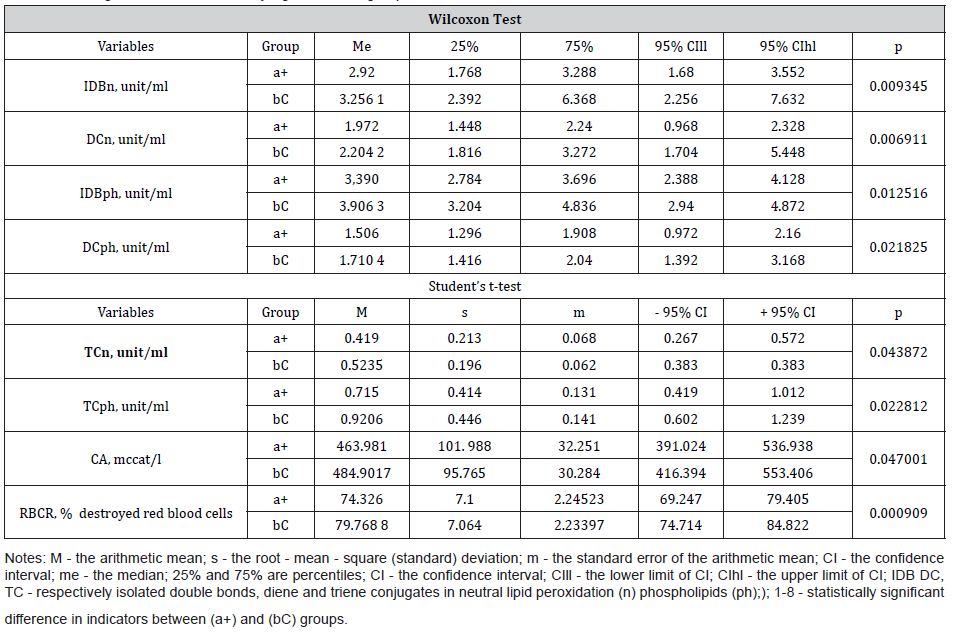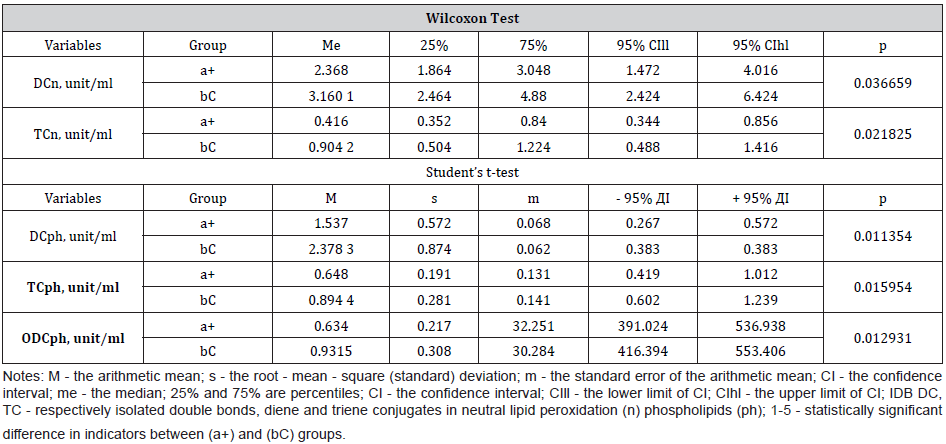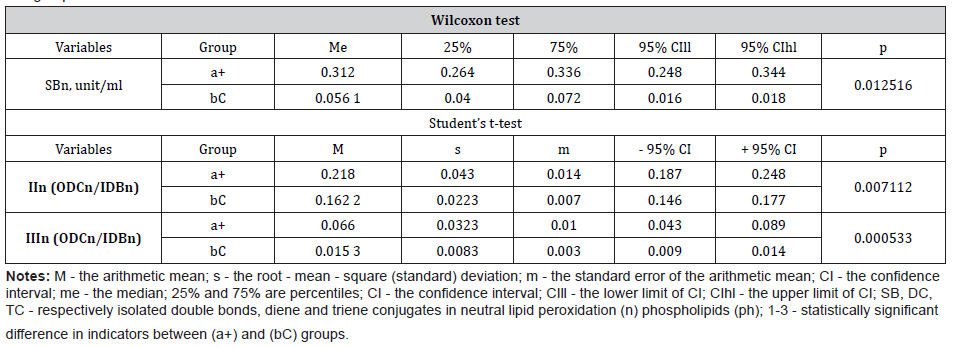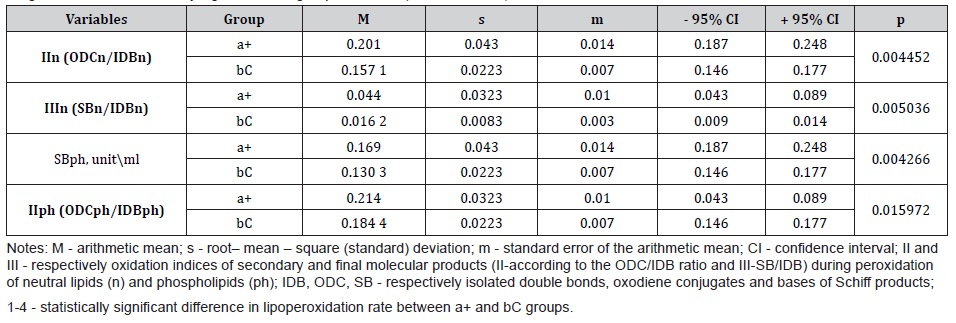Authored by Andrey Belousov*,
Abstract
The problem of increasing the functional activity preservation of red blood cells is priority for the Blood Service and clinical transfusiology. Taking into account the previously discovered unique properties of magnetite nanoparticles, namely: non-specific modulation of metabolic processes, strengthening of adaptive mechanisms of cellular organelles, acceleration of reparative processes at the level of membranes and macromolecules, for the first time an attempt was made to use the upgraded saline solution of sodium chloride (nanotechnologically upgraded solution - NUS) as a resuspending of erythrocyte-containing components (ECC).
Objective: to improve the preservation of red blood cells containing donor blood components using NUS for resuspending. To achieve this goal, the first stage of the study examined the effect of a new resuspending solution (NUS) on lipoperoxidation, catalase activity, and red blood cell peroxidation resistance in donor blood components containing red blood cells.
Object of research: red blood cells from preservation blood of donors, which are intended for component transfusion therapy.
Materials and methods: The upgraded resuspending solution was obtained by treating saline sodium chloride with standardized magnetite nanoparticles (ICNB brand) using the Belousov’s method with complete removal of NPs from the solution. Evaluation of the activity of lipid peroxidation (POL) processes was carried out by the spectrophotometric method’s Volchegorsky. The optical density of each phase was measured on a Helios spectrophotometer. Statistical verification of the obtained data was carried out using computer programs STATISTICA 6.1.
Research and Result: As a result of the study, the advantages of using NUS were established, namely: a significant decrease in the levels of primary and secondary lipid peroxidation products in the first 15 days of observation, an increase in catalase activity and resistance of red blood cells to peroxidation in the first stages of the study, inhibition of the shear reaction with neutral lipid peroxidation in the late stages of observation.
Conclusion: The saline sodium chloride solution which nanotechnologically upgraded by standardized biocompatible forms of NPs magnetite, has a positive effect on the ECC of donor blood when used as a resuspending agent. The advantage of exposure to this solution was a decrease in the intensity of POL reactions, an increase in catalase activity (CA) and red blood cells resistance (RBCR) on the first or second day after resuspending the erythrocytes were compared with a standard solution.
Keywords: Nanomodified resuspending solution; Oxidative homeostasis; Peroxide resistance of red blood cells; Components containing red blood cells; Storage
Introduction
Extending the shelf life of blood taken from a donor is a problematic area in the field of industrial transfusiology, which is currently receiving great attention. The global trend towards an increase in the shortage of donor personnel encourages the development of new technologies to provide a reserve supply of donor blood in case of extreme situations, as well as the effective use of auto-blood blood for planned operations. Modernization of canning and storage technologies should allow for more free management of these resources. Thus, it was found that extending the shelf life of blood by 1 week reduces the volume of collected blood by 3-8%, reduces its deficiency associated with the shelf life [1,2]. In addition, it is known that the effectiveness of blood transfusion therapy largely depends on the use of effective hemoconservants and solutions for resuspending. Therefore, the problem of improving methods and means of preserving blood and its components does not lose its relevance.
One of the most important components preservation of blood is red blood cells, the transfusion of which ensures efficient transportation of oxygen in the patient’s body. In this regard, it should be noted that substances that are introduced into preservative solutions allow maintaining the metabolism of red blood cells for a long time at a level close to the physiological norm. Additional solutions, depending on their purpose, serve as an additional support for the functional usefulness of blood cell components during storage and/or are used to bring the hematocrit of the transfusion medium to physiological parameters by resuspending cells. The point of developing new forms of resuspending solutions is to ensure long-term support of metabolic processes in cells at a level as close as possible to the physiological level. Therefore, improving the means of maintaining the functional activity of red blood cells during their storage is the primary task of industrial transfusiology and scientists working in the field of cell physiology.
Separately, it should be noted that in the last decade, with the emergence of a new promising direction of nanobiotechnologies, there has been a significant increase in both the production of nanomaterials and the expansion of their application areas. Studying the structures and functions of natural nano constructions that exist in a living cell is a necessary step for creating nano biopreparations. As in the rest of the world, a number of medical nanotechnological products appeared in Ukraine at the end of the twentieth century. Among them: the ICNB (nano biocorrector for intravenous), the magnet-controlled sorbent (MCS-B brand), and the biologically active additive (Micromage-B brand) [3-7]. These drugs are based on magnetite (Fe3O4) nanoparticles (NPs) ranging in size from 6 to 12 nm, which are currently classified as priority artificial NPs for legitimate use [8-13]. An important advantage of this material is its highly specific (selective) sorption properties, which creates prerequisites for the occurrence of indirect sanogenetic effects during therapy.
So, the principle of therapeutic action of these nanotechnological drugs is the positive effect of the adsorption process and the constant magnetic field surrounding the magnetite NPs on cellular and subcellular structures, as well as in changing the orientation and mobility of hydrogen nuclear spins in the water molecule. The point of application is the surface proteins of cell membranes. Magnetite NPs alter the composition of protein molecules and the polarization structure of the cellular microenvironment, actively affecting the transport of substances into the cell [14-16]. A unique property of these drugs is non-specific modulation of metabolic processes. Thus, these NPs cause an increase in adaptive-adaptive potential mechanisms and capabilities of cellular organelles, accelerate reparative processes at the level of membranes and macromolecules [17,18]. It was also found that these magnetite NPs act as a modulating factor for such phenomena as metabolic processes in white blood cells, the work of the enzyme link of the antioxidant system in red blood cells of healthy and sick people [19].
All of the above determined the purpose and objectives of this study, which is related to the development of new forms of resuspending solutions for red blood cells. To achieve this goal, at the first stage of research, the effect of a new resuspending solution (NUS) on the indicators of oxidative homeostasis and peroxide resistance of red blood cells in red blood cell-containing components of donor blood was studied. Object of Research: red blood cells from preservation of blood of donors which are intended for component transfusion therapy.
Materials and Methods
The upgraded resuspending solution was obtained by treating saline sodium chloride with standardized magnetite nanoparticles (ICNB) using the Belousov’s method [7] with complete removal of NPs from the solution. Magnetite NPs synthesized by coprecipitation method. Basic physical and chemical properties of ICNB:
• Concentration of the colloidal solution of magnetite NPs in physiology solution of NaCl is 0.0225%.
• Theoretical osmolality of colloid solution is 500 mosmol/l
• Size of magnetite nanoparticles is 6-12 nm;
• Total area of surface magnetite of nanoparticles Ss = 800- 1200 m2/g;
• Magnetization of saturation Is = 2.15 кА/m;
• ζ - potential = - 19 mV.
Erythrocyte-containing components (ECC) obtained according to the standard method from the peripheral blood of adult healthy donors prepared on the preservative CPDA-1 were studied (n = 20, 160 studies). To study the effect of a nanotechnologically upgraded 0.9% NaCl solution, the component containing red blood cells was divided into 2 equal aliquots. Red blood cells from the first aliquot (A1) were resuspended in a modified saline solution of sodium chloride (a+). As a control, a second aliquot (A2) was used, in which a standard saline solution of sodium chloride (bK) was used to resuspend red blood cells. Resuspended red blood cells were stored under hypothermia (temperature 2-6 °C) and examined for 2, 9, 16, 23, 30, 37, 44, 49-per day from the moment the beginning of blood preservation (then - sequentially stage I, II, III, IV, V, VI, VII, VIII).
Evaluation of the activity of lipid peroxidation (POL) processes was carried out by the spectrophotometric method’s Volchegorsky [20] in the modification [21], which makes it possible to differentiate the products of peroxidation of phospholipids (ph) extracted in the isopropanol phase and neutral lipids (n) extracted in the heptane phase. The optical density of each phase was measured on a Helios spectrophotometer at a wavelength of () = 220 nm, reflecting the content of isolated double bonds (IDB) in the extracted unsaturated fatty acid substrates. The concentration of diene conjugates (DC) was observed at = 232 nm; triene conjugates (TC) – at IC = 268 nm oxidiene conjugates (ODC) - at = 278 nm and end Schiff bases products (SB) - at = 400 nm. The control was heptane I and the isopropanol phase of water. Catalase (CA) activity [22], glucose content [23], and levels of red blood cells resistance to peroxide (RBCR) were also determined [24]. Statistical verification of the obtained data was carried out using computer programs STATISTICA 6.1 (StatSoft, USA) [25-27].
Research and Result
Table 1 shows data on indicators that had a statistically significant difference at the first stage of the study between the control and experimental groups (Table 1).
Table 1:The POL, CA and RBCR indicators in red blood cell samples containing the component of the experimental (a+) and control (bC) groups, which at the stage I showed a statistically significant intergroup difference.

The data in Table 1 show that after 24 hours of storage of erythrocyte-containing components (ECC) under hypothermia conditions in the samples of the experimental (a+) group, the concentrations of TCn and TCph were 1.3 times lower, and the values of CA and RBCR - were 4.3% and 5.4%, respectively, compared with similar values in the control (bC) group.
At the third stage of the study (two weeks of ECC storage), 5 lipoperoxidation indicators (POL) were detected, the level of which in the samples of the a+ group was statistically significantly lower than in the bC group (tabl. 2). The CA and RBCR indicators at the third stage did not differ statistically significantly between the groups (Table 2).
The data in Table 2 show that at Stage III of the study, according to the Student’s t-test, the main group (a+) has a statistically lower level of DCph compared to the control (bC) group – by 1.6 times (P = 0.011354), TCph – by 1.4 (p = 0.015954) and ODCph – by 1.5 times (P = 0.012931).
Table 2: Lipoperoxidation (Pol) data in red blood cell samples containing the experimental (a+) and control (bC) groups, which at Stage III showed a statistically significant intergroup difference.

Table 2 also shows that the processes of peroxidation of neutral lipids in the experimental group compared to the control group were 1.3 times lower, and the concentrations of DCn (P = 0.036659) and TCn - 2.2 times (P = 0.021825). Subsequent storage of ECC (stages IV and V of the study) showed intergroup differences in the formation of lipid peroxidation end-products (Table 3,4).
Table 3:Lipoperoxidation indicators in the ECC of the experimental (a+) and control (bC) groups, which at Stage IV showed a statistically significant intergroup difference.

Table 4:Lipoperoxidation indicators in red blood cell samples containing a component of the experimental (a+) and control (bC) groups, which at Stage V showed a statistically significant intergroup difference (Student’s t-test).

Tables 3, 4 show that at stages IV and V of the study, there is a statistically significant difference in the content of BSn, BSph, as well as in the oxidation rates of secondary (IIn – ODCn/IDBn ratio, IIph (ODCph/IDBph) and final (IIIn – BSn/IDBn ratio) molecular LPo products. Further statistical analysis of the data (starting from Stage VI and ending with Stage VIII) did not reveal significant differences between POL, CA and RBCR indicators between the samples of the experimental and control groups.
Thus, the results of the conducted studies showed that the use of experimental NUS for resuspending improves the quality properties of preservation of blood by reducing the concentration of primary and secondary molecular products of POL during the first 15 days of canning in hypothermia. The applied solution significantly reduces formation bases of Schiff products at stages IV-V of the study and, as a result, reduces the concentration of POL final products. There was not statistically significant difference between the studied indicators between the experimental and control groups starting from Stage VI and up to Stage VIII inclusive. Statistically significant intergroup differences in CA and RBCR indicators were found only at the stage I. Changes in POL values correlate with the storage time of ECC samples.
Discussion
It is known that the potential of nanoparticles for medical Biotechnologies lies primarily in their use as diagnostic tools, drug delivery, and therapy [28-30]. Modification of NPs surfaces significantly affects the physical, chemical, and biological nature of entire molecules in biological systems [31]. The main risk factor for the use of medical nanotechnologies is their possible toxicity, potential ability to damage biomembranes and affect the function of biomolecules, including cellular organelles. The mechanism of action of NPs is associated with the formation of free radicals in the presence of nanoobjects [32,33]. The NUS used in this study does not contain magnetite NPs due to the use of a special technology for their pre-removal after exposure to solution molecules [7]. Based on the results of studies of the effect of two resuspending solutions on oxidative homeostasis indicators, it was found that at the first three stages (15 days of storage), the advantage was on the side of experimental NUS due to a statistically significant decrease in the level of primary and secondary POL products, including IDBn, DCn, TCn, IDBph, DCph, TCph, relative to the data recorded in the control group. The intergroup difference in the first stages of the study was confirmed by other methods (according to CA and RBCR data).
In addition, resuspending in NUS inhibited the shear reaction during neutral lipid peroxidation in the late stages of storage. Thus, there is a statistically significant intergroup difference in the SBn content (p = 0.012516 according to the Wilcoxon test) and the oxidation rates of secondary and final POL molecular products (respectively: ODCn/ IDBn ratio, p = 0.007112 and SBn/ IDBn, p = 0.000533 according to the Student’s t-test). Such results were obtained due to the effect of NUS on the metabolism of red blood cells for resuspending when the structure of liquid medium molecules changes under the influence of NPs magnetite [34]. The NUS used in the study is as simple as possible in composition and, therefore, is available for technological reproduction in Blood Service Institutions. Due to the complete removal of NPs, the drug meets the requirements for such decisions by regulatory authorities.
Conclusion
The saline sodium chloride solution which nanotechnologically upgraded by standardized biocompatible forms of NPs magnetite, has a positive effect on the ECC of donor blood when used as a resuspending agent. The advantage of exposure to this solution was a decrease in the intensity of POL reactions, an increase in CA and RBCR on the first or second day after resuspending the erythrocytes were compared with a standard solution.
To read more about this article....Open access Journal of Biomedical Engineering & Biotechnology
Please follow the URL to access more information about this article
To know more about our Journals...Iris Publishers





No comments:
Post a Comment